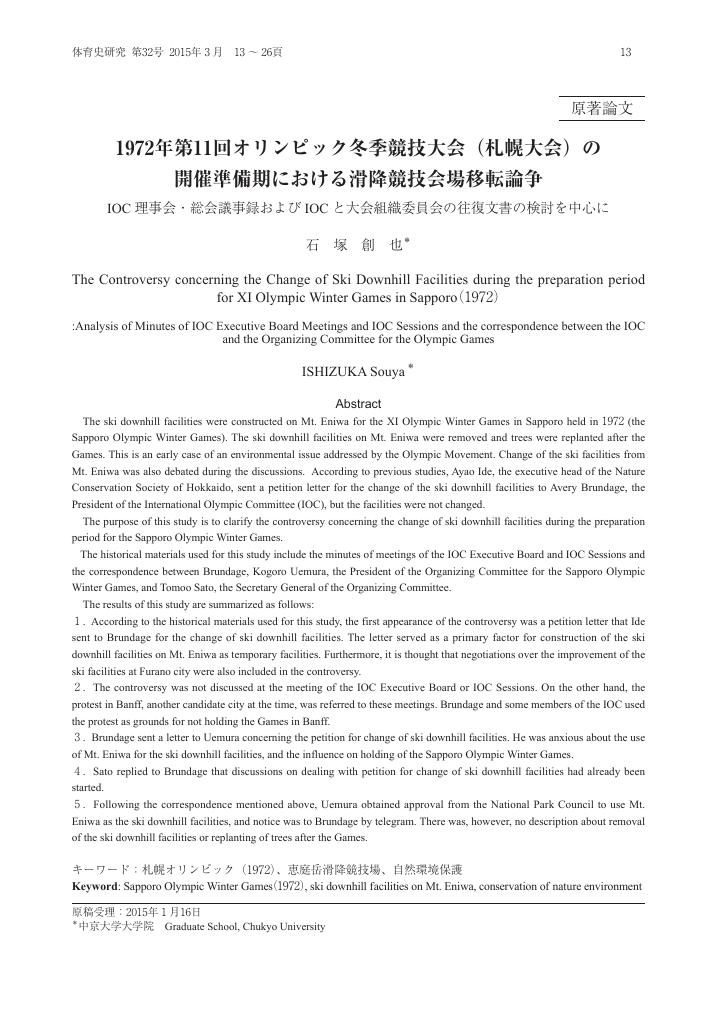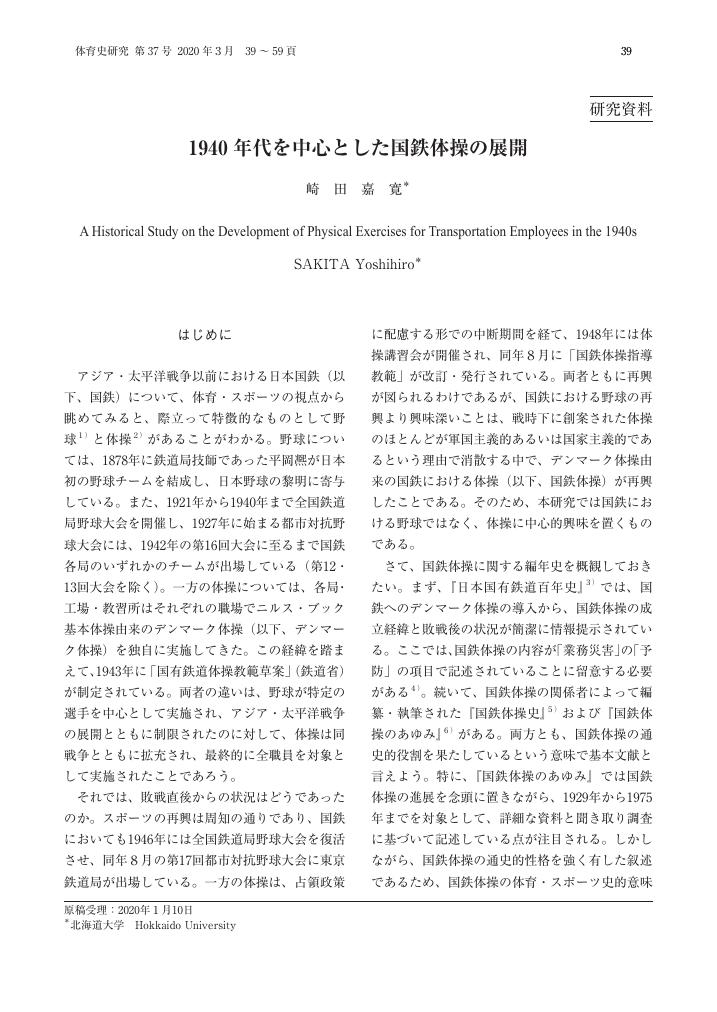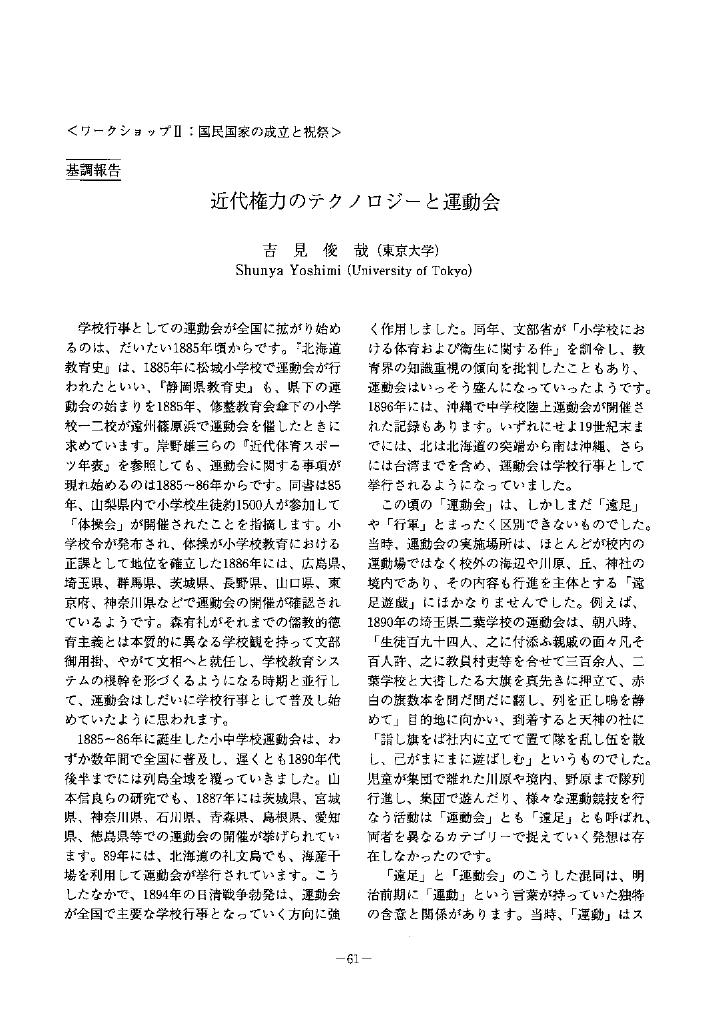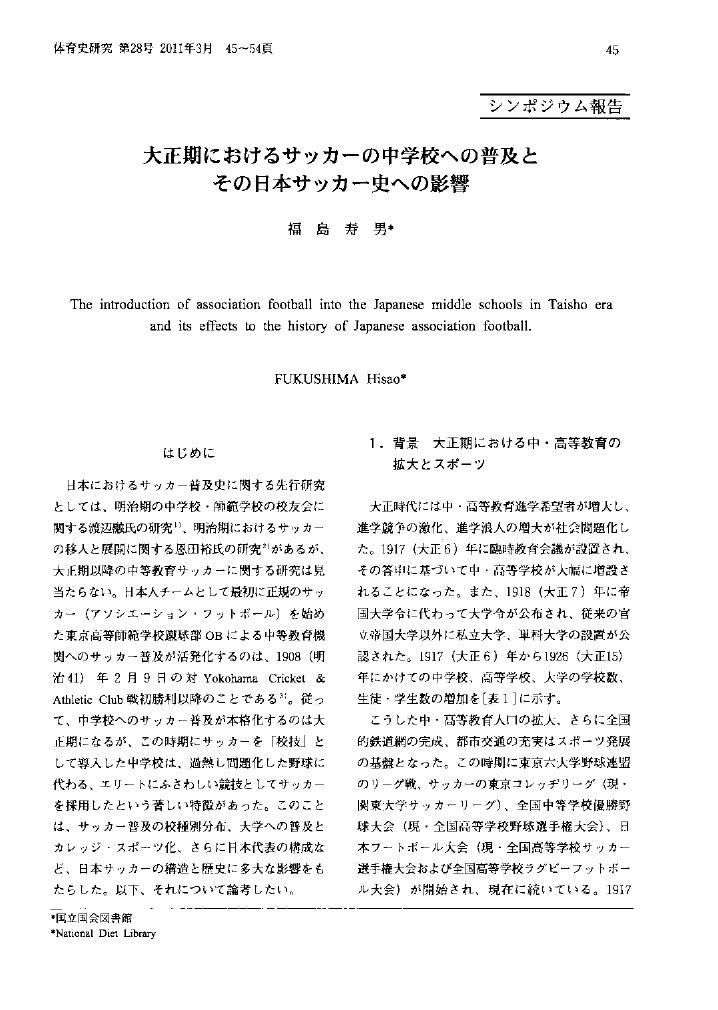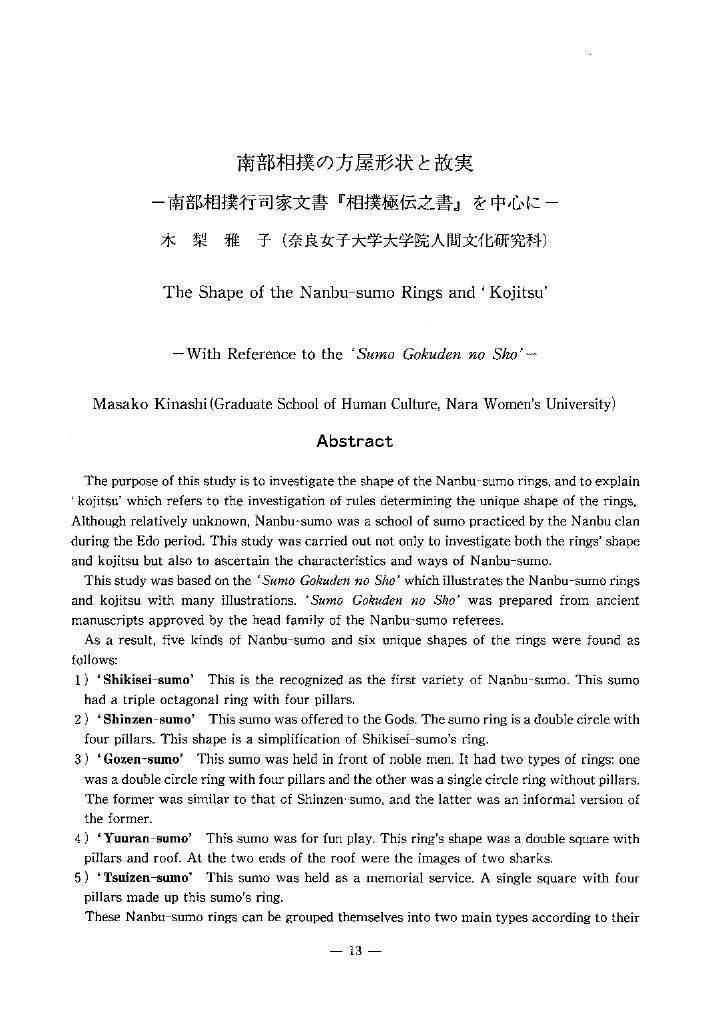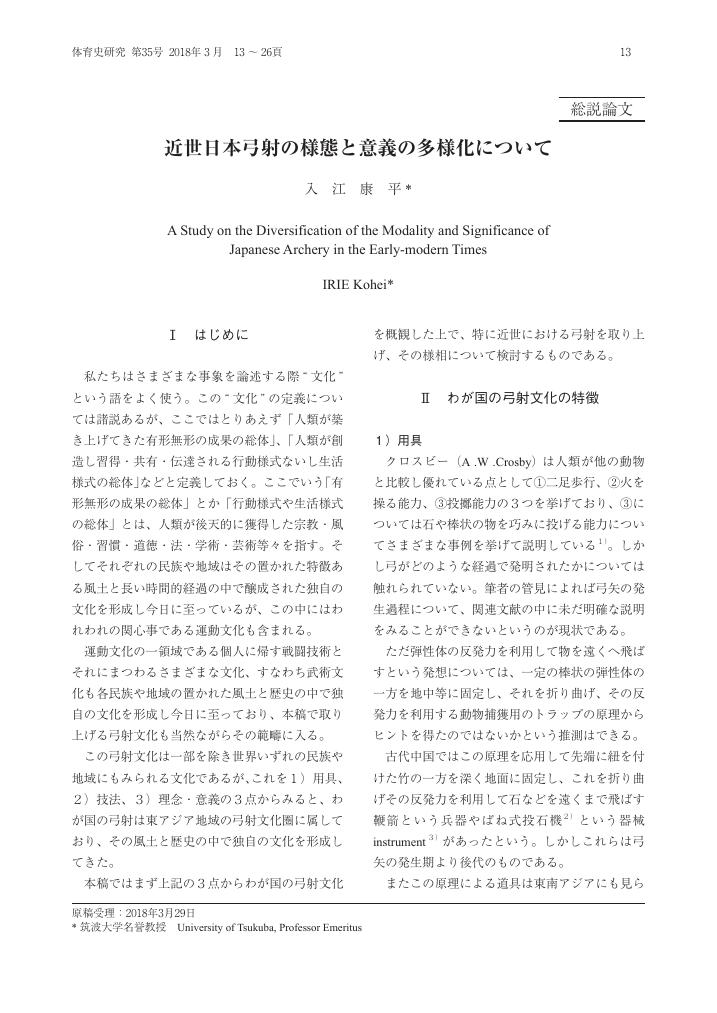11 0 0 0 OA 19世紀末ロンドンにおける墓地跡地の都市公園及び運動場への転用に関する体育史的考察 ――Metropolitan Public Gardens Associationによる慈善事業としての用地転用の実相――
- 著者
- 川村 若菜
- 出版者
- 体育史学会
- 雑誌
- 体育史研究 (ISSN:09144730)
- 巻号頁・発行日
- vol.40, pp.17-28, 2023 (Released:2023-08-13)
The Studies of British sports history mention the reform of sports and recreational activities for urban residents by middle-class people trying to promote rational recreation. However, it has not been clear how the sports environment needed for sports and recreational activities was developed. This study focuses on the Metropolitan Public Gardens Association (MPGA), which established urban parks and recreation grounds for city residents in late 19th century London. Specifically, this study will clarify the actual situation of one of its major projects, the conversion of a disused burial grounds into an urban park and recreation grounds. The primary source material used in this study was the MPGA's Annual Reports (1884-1904). The results showed that the MPGA was not only developing the disused burial grounds as parks, but also carrying out actions to make them more comfortable and accessible areas for recreation, and to promote exercise opportunities people including school children. Such projects were implemented especially in poverty affected areas.
- 著者
- 石塚 創也
- 出版者
- 体育史学会
- 雑誌
- 体育史研究 (ISSN:09144730)
- 巻号頁・発行日
- vol.32, pp.13-26, 2015 (Released:2022-10-10)
4 0 0 0 OA 1940年代を中心とした国鉄体操の展開
- 著者
- 崎田 嘉寛
- 出版者
- 体育史学会
- 雑誌
- 体育史研究 (ISSN:09144730)
- 巻号頁・発行日
- vol.37, pp.39-59, 2020 (Released:2022-09-25)
3 0 0 0 OA ワークショップⅡ:国民国家の成立と祝祭 基調報告 近代権力のテクノロジーと運動会
- 著者
- 吉見 俊哉
- 出版者
- 体育史学会
- 雑誌
- 体育史研究 (ISSN:09144730)
- 巻号頁・発行日
- vol.15, pp.61-70, 1998 (Released:2022-10-08)
- 著者
- 鈴木 明哲
- 出版者
- 体育史学会
- 雑誌
- 体育史研究 (ISSN:09144730)
- 巻号頁・発行日
- vol.40, pp.29-40, 2023 (Released:2023-08-13)
This paper considers how the partner exercise has been retained in physical education practice and school sports festival from elementary school to senior high school in japan after deleted from the course of study. The partner exercise was deleted from the course of study were 1953 in elementary school, 1958 in junior high school and 1960 in senior high school. The Ministry of Education by the official daily gazette from 1958, in addition, strengthened the restriction of the course of study. The most important part of this argument is that the reason why the partner exercise has been retained in the physical education practice and the school sports festival under strengthened the restriction of the course of study. The results of the considerations are summarized follows: In the course of study in elementary school (1949), the partner exercise belonged to the part of the calisthenics composed of three children without the pyramid building. Since the partner exercise deleted from the course of study in elementary school (1953), a lot of teachers through the discussion in physical education magazine recognized that the partner exercise is the same as the calisthenics. Therefore, the partner exercise has been exist in physical education practice in order to training physical fitness and mind. In the course of study in junior high school and senior high school (1951), the partner exercise belonged to the part of the “Kohgi” (= apparatus gymnastics, pyramid building, stunts and tumbling). Since the “Kohgi” deleted from the course of study in junior high school (1958) and senior high school (1960), the partner exercise recognized the calisthenics as like elementary school has been retained in physical education practice. A further important point is the relationship between the physical education practice and the school sports festival over the partner exercise. The partner exercise has been placed in the program of the school sports festival before practiced in physical education. Performing the partner exercise in the school sports festival needed a lot of time to prepare it, because many teachers and audience sought high performance for students. As a result, the partner exercise was practiced in physical education course in all year in order to complete it in the school sports festival. Finally, the main reason why the partner exercise has been exist in the whole school after deleted from the course of study was that a lot of teachers gave it highly educational philosophy which the character building through the school life.
2 0 0 0 OA 第2回日本厚生大会(1939)の実際:名古屋市の準備動向に着目して
- 著者
- 関口 雄飛
- 出版者
- 体育史学会
- 雑誌
- 体育史研究 (ISSN:09144730)
- 巻号頁・発行日
- vol.40, pp.1-15, 2023 (Released:2023-08-13)
The purpose of this study is to consider the significance of the 2nd Japan Recreation Congress (JRC) for Nagoya City by clarifying the progress of preparations for the 2nd JRC, focusing on the trends of Nagoya City. Since the announcement of the 2nd JRC the city has invested 1.6 times the amount spent on the 1st JRC was for hosting the congress, including athletic events at the municipal general stadium under construction. The city expects about 100,000 people to attend the event. Nagoya City, has formed a preparatory committee to plan the 2nd JRC, Nagoya City decided to set up a specialized subcommittee, and prepare a draft congress for each of the four departments, except general affairs. However, even after about three months, as of July 1939, not much progress was made in the drafting of the congress agenda. Furthermore, the establishment of a specialized subcommittee, which was mentioned several times, was not realized. It is probable that the sluggish preparations can be attributed to personnel problems involving city hall leaders. Shortly after the decision to hold the 2nd JRC in Nagoya, the city hall leaders resigned. In response, the city hall was forced to take action for about eight months to replace the mayor, first and second assistants, and four of the five directors who were supposed to organize the convention preparatory committee. With the reforms initiated by the newly appointed mayor, preparations for the 2nd JRC, which were in a stalemate, began to progress. However, the 2nd JRC continued to be embroiled in controversies. In mid–July, the session was delayed from early October to mid-November, and the venue was shifted from the general playground to the Tsurumai Park playground. Owing to the change of the session to mid–November, the plan to hold the 2nd JRC in connection with the municipal anniversary was abandoned, and the venue was changed to Tsurumai Park Athletic Field, Correspondingly, all the athletics events were changed. As for the acting event that were expected to be covered, it was inevitably necessary to consider the ones that can be conducted in the Volleyball court, Basketball court, Athletics field, Football court, Tennis court, etc. that are located in the park. In addition, the session was shortened to four days instead of five days, and the participation status of German and Italian representatives was changed to non–participation due to the influence of World War II. Dainikai Koshin (The second march) at the 2nd JRC was not criticized for mobilizing a large number of citizens. Meanwhile, Shimin Kosei Kyogi Taikai (The Citizens' Recreation competition) was severely criticized for not being able to mobilize a large number of citizens, and Kosei no Yube (Entertainment event) for not being able to think through the placement of the acting discipline. Subsequently, the event was held on a small scale in an unintended manner, and in terms of mobilizing citizens, it can be said that the tournament can be considered a failure.
2 0 0 0 OA 比較文学で明治期日本の陸上競技を読む
- 著者
- 牛村 圭
- 出版者
- 体育史学会
- 雑誌
- 体育史研究 (ISSN:09144730)
- 巻号頁・発行日
- vol.40, pp.69-82, 2023 (Released:2023-08-13)
2 0 0 0 OA (シンポジウム報告)大正期におけるサッカーの中学校への普及とその日本サッカー史への影響
- 著者
- 福島 寿男
- 出版者
- 体育史学会
- 雑誌
- 体育史研究 (ISSN:09144730)
- 巻号頁・発行日
- vol.28, pp.45-54, 2011 (Released:2022-10-20)
2 0 0 0 『教訓抄』巻第七の舞踊理論について
- 著者
- 康 冬玲
- 出版者
- 日本体育学会体育史専門分科会
- 雑誌
- 体育史研究 (ISSN:09144730)
- 巻号頁・発行日
- no.18, pp.1-12, 2001-03
- 著者
- 秋元 忍
- 出版者
- 日本体育学会体育史専門分科会
- 雑誌
- 体育史研究 (ISSN:09144730)
- 巻号頁・発行日
- no.23, pp.123-132, 2006-03
1 0 0 0 OA 札幌農学校のミリタリー・ドリル 担当教員の推移を中心として
- 著者
- 鈴木 敏夫
- 出版者
- 体育史学会
- 雑誌
- 体育史研究 (ISSN:09144730)
- 巻号頁・発行日
- vol.17, pp.33-44, 2000 (Released:2022-10-12)
1 0 0 0 OA 薩摩の「ハマ投げ」に関する研究
- 著者
- 山田 理恵
- 出版者
- 体育史学会
- 雑誌
- 体育史研究 (ISSN:09144730)
- 巻号頁・発行日
- vol.20, pp.13-22, 2003 (Released:2022-10-12)
1 0 0 0 OA 書評 星野映・中嶋哲也・磯直樹編著『フランス柔道とは何か:教育・学校・スポーツ』
- 著者
- 和田 浩一
- 出版者
- 体育史学会
- 雑誌
- 体育史研究 (ISSN:09144730)
- 巻号頁・発行日
- vol.40, pp.111-113, 2023 (Released:2023-08-13)
1 0 0 0 OA 南部相撲の方屋形状と故実 南部相撲行司家文書『相撲極伝之書』を中心に
- 著者
- 木梨 雅子
- 出版者
- 体育史学会
- 雑誌
- 体育史研究 (ISSN:09144730)
- 巻号頁・発行日
- vol.16, pp.13-24, 1999 (Released:2022-10-08)
1 0 0 0 OA 大日本帝国海軍におけるデンマーク体操の受容と民間への普及
- 著者
- 崎田 嘉寛
- 出版者
- 体育史学会
- 雑誌
- 体育史研究 (ISSN:09144730)
- 巻号頁・発行日
- vol.36, pp.73-92, 2019 (Released:2022-09-25)
1 0 0 0 OA 近世日本弓射の様態と意義の多様化について
- 著者
- 入江 康平
- 出版者
- 体育史学会
- 雑誌
- 体育史研究 (ISSN:09144730)
- 巻号頁・発行日
- vol.35, pp.13-26, 2018 (Released:2022-09-18)
1 0 0 0 OA 比較民俗学からみた日本の竹馬の系譜
- 著者
- 寒川 恒夫
- 出版者
- 体育史学会
- 雑誌
- 体育史研究 (ISSN:09144730)
- 巻号頁・発行日
- vol.5, pp.1-6, 1988 (Released:2022-09-30)
- 著者
- 都筑 真
- 出版者
- 体育史学会
- 雑誌
- 体育史研究 (ISSN:09144730)
- 巻号頁・発行日
- vol.24, pp.123-125, 2007 (Released:2022-10-17)
1 0 0 0 『続教訓抄』の舞踊理論について
- 著者
- 康 冬玲
- 出版者
- 日本体育学会体育史専門分科会
- 雑誌
- 体育史研究 (ISSN:09144730)
- 巻号頁・発行日
- no.19, pp.1-13, 2002-03
1 0 0 0 『體源抄』の舞踊理論について
- 著者
- 康 冬玲
- 出版者
- 日本体育学会体育史専門分科会
- 雑誌
- 体育史研究 (ISSN:09144730)
- 巻号頁・発行日
- no.20, pp.1-11, 2003-03
